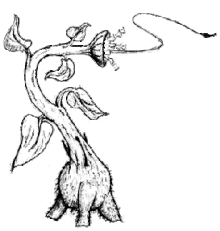Triffid
| Triffid | |
|---|---|

A triffid as illustrated by Wyndham
|
|
| First appearance |
The Day of the Triffids (1951 novel) |
| Last appearance |
The Day of the Triffids (2009 TV series) |
| Created by | John Wyndham |
| Information | |
| Type | Carnivorous plant |
The triffid is a fictitious tall, mobile, prolific and highly venomous plant species, the titular antagonist in John Wyndham's 1951 novel The Day of the Triffids and Simon Clark's 2001 sequel The Night of the Triffids. Triffids were also featured in the 1957 BBC radio dramatization of Wyndham's book, a considerably altered 1962 film adaptation, a more faithful 1981 television serial produced by the BBC, and in a 2009 two-part TV series also produced by the BBC.
Since 1951, when The Day of the Triffids was first published, the word "triffid" has become a popular British English colloquial term for large, overgrown or menacing-looking plants.
The origin of the triffid species is never fully revealed in Wyndham's novel. The novel's central character, Bill Masen, dismisses the idea that they are a naturally occurring species, or that they are extraterrestrial in origin:
My own belief, for what that is worth, is that they were the outcome of a series of ingenious biological meddlings—and very likely accidental, at that. Had they been evolved anywhere but in the region they were, we should doubtless have had a well‑documented ancestry for them.
The 1981 TV series and some editions of the book have Masen speculating that the triffids were the creation of the real-life Soviet biologist Trofim Lysenko. According to Masen's narration, the triffids first came to the attention of the Western world when a man named Umberto Christoforo Palanguez presented the Arctic & European Fish Oil Company with a mysterious vegetable oil originating from Russia. Once the scientists of Arctic & European realised how potent the oil was, Palanguez' offer to smuggle some seeds of the plant out of Russia was accepted. Palanguez disappeared, but Masen guesses that his plane carrying the triffid seeds was shot down by the Red Air Force, allowing the seeds to be carried all over the globe by wind.
...
Wikipedia
